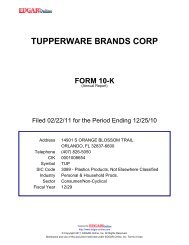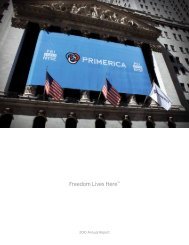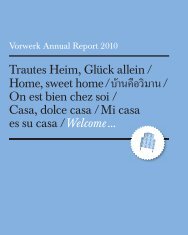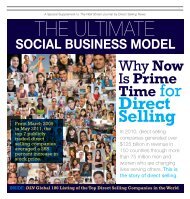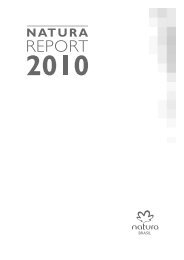Nu Skin 2010 Annual Report - Direct Selling News
Nu Skin 2010 Annual Report - Direct Selling News
Nu Skin 2010 Annual Report - Direct Selling News
You also want an ePaper? Increase the reach of your titles
YUMPU automatically turns print PDFs into web optimized ePapers that Google loves.
NU SKIN ENTERPRISES, INC.<br />
Notes to Consolidated Financial Statements<br />
18. RESTRUCTURING CHARGES<br />
During 2009, the Company recorded restructuring charges of<br />
$10.7 million, related to restructuring of its Japan operations, including<br />
an approximate 30% headcount reduction as well as facility relocations<br />
and closures. $7.4 million related to severance payments to terminated<br />
employees and $3.3 million of these charges related to facility relocation<br />
or closing costs. The majority of these severance charges are related<br />
to a voluntary employment reduction program. The restructuring<br />
charges for facility relocation or closing costs related to costs<br />
incurred during 2009 for leases terminated in that period.<br />
19. COMMITMENTS AND CONTINGENCIES<br />
The Company is subject to governmental regulations pertaining<br />
to product formulation, labeling and packaging, product claims and<br />
advertising and to the Company’s direct selling system. The Company<br />
is also subject to the jurisdiction of numerous foreign tax and customs<br />
authorities. Any assertions or determination that either the Company<br />
or the Company’s distributors is not in compliance with existing statutes,<br />
laws, rules or regulations could potentially have a material adverse<br />
effect on the Company’s operations. In addition, in any country or jurisdiction,<br />
the adoption of new statutes, laws, rules or regulations or<br />
changes in the interpretation of existing statutes, laws, rules or regulations<br />
could have a material adverse effect on the Company and its<br />
operations. Although management believes that the Company is in<br />
compliance, in all material respects, with the statutes, laws, rules and<br />
regulations of every jurisdiction in which it operates, no assurance can<br />
be given that the Company’s compliance with applicable statutes, laws,<br />
rules and regulations will not be challenged by foreign authorities or<br />
that such challenges will not have a material adverse effect on the<br />
Company’s financial position or results of operations or cash flows. The<br />
Company and its Subsidiaries are defendants in litigation and proceedings<br />
involving various matters. Except as noted below, in the opinion of<br />
the Company’s management, based upon advice of its counsel handling<br />
such litigation and proceedings, adverse outcomes, if any, will not<br />
likely result in a material effect on the Company’s consolidated financial<br />
condition, results of operations or cash flows.<br />
The Company is subject to regular audits by federal, state and<br />
foreign tax authorities. These audits may result in additional tax liabilities.<br />
The Company believes it has appropriately provided for income<br />
taxes for all years. Several factors drive the calculation of its tax reserves.<br />
Some of these factors include: (i) the expiration of various<br />
statutes of limitations; (ii) changes in tax law and regulations; (iii) issuance<br />
of tax rulings; and (iv) settlements with tax authorities. Changes<br />
in any of these factors may result in adjustments to the Company’s<br />
reserves, which would impact its reported financial results.<br />
Due to the international nature of the Company’s business, the<br />
Company is subject from time to time to reviews and audits by the<br />
foreign taxing authorities of the various jurisdictions in which the<br />
Company conducts business throughout the world. The Company is<br />
currently involved in two separate disputes with the customs authorities<br />
in Japan with respect to duty assessments on several of the<br />
Company’s Pharmanex nutritional products totaling approximately<br />
5.3 billion Japanese yen as of December 31, <strong>2010</strong> (approximately<br />
$65.3 million), net of any recovery of consumption taxes. The Company<br />
was also recently notified that it is likely to receive an additional<br />
assessment of 0.6 billion Japanese yen (approximately $7.7 million)<br />
related to the second dispute.<br />
The first dispute relates to additional customs assessments<br />
made by Yokohama Customs for the period of October 2002<br />
through July 2005. The aggregate amount of these additional assessments<br />
is 2.7 billion Japanese yen (approximately $33.2 million as<br />
of December 31, <strong>2010</strong>), net of any recovery of consumption taxes.<br />
The dispute relates to whether the Company used the proper valuation<br />
method for these products in determining the applicable customs<br />
duties. The primary legal issue in the case is whether the relevant<br />
import transaction is a sale between the Company’s third party<br />
manufacturers and the Company’s Japan subsidiary, or a sale between<br />
the Company’s US subsidiary and the Company’s Japan subsidiary.<br />
In 1999, the Company worked with the Yokohama Customs<br />
authorities to restructure the form of the relevant transactions in order<br />
to have the import transaction be a sale between the Company’s<br />
third party manufacturers and the Company’s Japan subsidiary, and<br />
thus have the duties assessed on the price paid to the Company’s<br />
third party manufacturers. With the input and guidance of the Yokohama<br />
Customs authorities, the Company restructured the form of<br />
the transaction and the agreements between the relevant parties<br />
based on these discussions so that the Company’s US subsidiary<br />
would be acting on behalf of the Company’s Japan subsidiary with<br />
respect to the purchase of these products rather than as a buyer/<br />
seller. The Company’s Japan subsidiary entered into a Memorandum<br />
of Understanding with each of the Company’s third party manufacturers<br />
of the relevant products, which provided that the Company’s<br />
Japan subsidiary was the purchaser of the products and that<br />
the Company’s US subsidiary was acting for and on behalf of the<br />
Company’s Japan subsidiary with respect to these products. The<br />
Company’s Japan subsidiary also entered into a Memorandum of<br />
74



